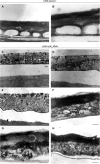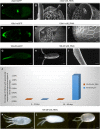Targeted Downregulation of s36 Protein Unearths its Cardinal Role in Chorion Biogenesis and Architecture during Drosophila melanogaster Oogenesis
- PMID: 27752139
- PMCID: PMC5067561
- DOI: 10.1038/srep35511
Targeted Downregulation of s36 Protein Unearths its Cardinal Role in Chorion Biogenesis and Architecture during Drosophila melanogaster Oogenesis
Abstract
Drosophila chorion represents a model biological system for the in vivo study of gene activity, epithelial development, extracellular-matrix assembly and morphogenetic-patterning control. It is produced during the late stages of oogenesis by epithelial follicle cells and develops into a highly organized multi-layered structure that exhibits regional specialization and radial complexity. Among the six major proteins involved in chorion's formation, the s36 and s38 ones are synthesized first and regulated in a cell type-specific and developmental stage-dependent manner. In our study, an RNAi-mediated silencing of s36 chorionic-gene expression specifically in the follicle-cell compartment of Drosophila ovary unearths the essential, and far from redundant, role of s36 protein in patterning establishment of chorion's regional specialization and radial complexity. Without perturbing the developmental courses of follicle- and nurse-cell clusters, the absence of s36 not only promotes chorion's fragility but also induces severe structural irregularities on chorion's surface and entirely impairs fly's fertility. Moreover, we herein unveil a novel function of s36 chorionic protein in the regulation of number and morphogenetic integrity of dorsal appendages in follicles sporadically undergoing aged fly-dependent stress.
Figures








References
-
- King R. C. In Ovarian Development in Drosophila melanogaster 35–84 (Academic Press, New York, 1970).
-
- Margolis J. & Spradling A. Identification and behavior of epithelial stem cells in the Drosophila ovary. Development 121, 3797–3807 (1995). - PubMed
-
- Margaritis L. H. In Comprehensive Insect Biochemistry, Physiology and Pharmacology. Vol. 1 (ed. Gilbert L. I., Kerkut G. A.) 151–230 (Pergammon Press, 1985).
-
- Margaritis L. H. The eggshell of Drosophila melanogaster. New staging characteristics and fine structural analysis of choriogenesis. Can J Zool. 64, 2152–2175 (1986).
MeSH terms
Substances
LinkOut - more resources
Full Text Sources
Other Literature Sources
Molecular Biology Databases

